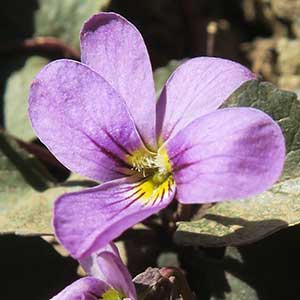Viola flettii
Viola septemloba
Flett's violet, Olympic violet, rock violet
southern coastal violet
1–3, ascending to erect, mostly glabrous, on caudex from fleshy rhizome.
basal and cauline;
basal: 1–3;
stipules linear-lanceolate, margins entire or with glandular processes, apex acuminate;
petiole 1.5–9.7 cm, mostly glabrous;
blade purple-tinted and –veined, broadly reniform to ovate, 0.9–2.4 × 1.2–4 cm, base cordate, margins finely crenate-serrate, eciliate, apex acute to obtuse, surfaces glabrous or sparsely pubescent along veins adaxially;
cauline similar to basal except: stipules ovate to lanceolate, margins entire or shallowly laciniate;
petiole 0.7–5.9 cm, usually glabrous;
blade 0.8–2.1 × 1.2–3.1 cm.
basal, 5 or 6, prostrate to ascending;
stipules linearlanceolate, margins entire, apex acute;
petiole 1.5–7 cm, usually glabrous;
earliest leaf blades ± ovate, sometimes 3-lobed, mid-season blades 7–9-lobed, 1–9 × 1–10 cm, base broadly cordate to cordate, middle lobes narrowly elliptic, lanceolate, spatulate, or obovate, (rarely linear), lateral lobes lanceolate or spatulate to falcate, margins usually entire, sometimes serrate, sometimes with narrowly deltate or falcate appendages or teeth, ciliate or eciliate, apex acute to mucronulate, surfaces usually glabrous.
1.8–7.1 cm, usually glabrous.
2–20 cm, usually glabrous.
sepals lanceolate, margins eciliate, auricles 0.5–1.5 mm;
petals soft reddish violet on both surfaces, all with yellow area basally, lower 3 dark violet-veined, lateral 2 bearded, lowest with white around yellow area, 10–15 mm, spur yellow, gibbous, 0.5–2 mm;
style head bearded; cleistogamous flowers axillary.
sepals lanceolate to ovate, margins ciliate or eciliate, auricles 0.5–1 mm;
petals light to dark blue-violet on both surfaces, lower 3 and sometimes upper 2 white basally, lower 3 darker violet-veined, lateral 2 densely bearded, spur sometimes bearded, lowest 15–25 mm, spur usually lilac, sometimes whitish, gibbous, 2–3 mm;
style head beardless; cleistogamous flowers on ascending to erect peduncles.
± spherical, 5–9 mm, glabrous.
ellipsoid, 11–14 mm, glabrous.
dark brown to brownish purple, 2.5–3 mm.
beige, mottled to bronze, 2–3 mm.
= 54.
Viola flettii
Viola septemloba
Viola flettii is endemic to the Olympic Mountains of northwestern Washington. C. S. McCreary (2005) noted that although morphologically and ecologically distinct, V. cuneata, V. flettii, and V. ocellata are closely related.
(Discussion copyrighted by Flora of North America; reprinted with permission.)
For years this heterophyllous species was either ignored or included in Viola palmata. C. L. Pollard (1898) and E. Brainerd (1910, 1921) treated it as V. insignis Pollard, a later homonym.
(Discussion copyrighted by Flora of North America; reprinted with permission.)


